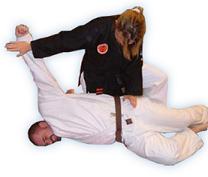|
Fundamentals
Hand Techniques
The uppercut and hook are effective close-range boxing punches and
are an important part of Goshin Jujutsu as well as the jab and cross. Elbow
strikes (where, technically speaking, the point of contact is actually about
an inch or two above the elbow on the forearm) are practiced going across to
the face, up under the chin, and down on the chest. These can also be
performed where the contact point is 1-2 inches towards the triceps and may
be used as a reverse strike in a rear bear hug, or as an elbow-drop to a
grounded opponent. Elbow strikes are arguably the most important close-range
strikes due to the forearm being such a strong part of the body. Something
that deserves comment is that the effectiveness of a punch is considerably
tied to proper hip-torque, which in turn is tied to proper footwork. This is
an important illustration of the inter-relationship between subjects that is
holds true throughout the system.
Kicks
There is a preference in Goshin Jujutsu for simple low-to-mid-level
kicks, the most common is a Karate style front kick (contact point is the
ball of the foot, target is bladder or groin), roundhouse (contact point is
the bridge of the foot, target is usually stomach or side of body), the side
kick, and Muay Thai-style leg kicks (usually striking with the shin where
target is the opponent’s knee or side of leg). Knee-strikes, technically
speaking, are classified as kicks in Goshin Jujitsu and are used in
close-range
Ukemi (Falling /Rolling)
Ukemi is a fundamental skill that is a part of every class. Forward
shoulder rolls (off both sides), break falls (both sides), front-fall,
back-fall, side-fall, flip, etc. There is a minor point worth mentioning on
forward shoulder rolls and breakfalls: there are two ways in which the hand
can be placed when rolling, on the back of the hand which is more
traditional, and rolling with the palms facing the floor. As the system is
designed for real-life usage, some schools will engage in periodic tests to
see whether rolls can be performed smoothly on non-mat surfaces such as at a
park or on hardwood floors.
Stances & footwork
Stances and footwork are a meld of boxing and traditional martial
arts. As in boxing, the closer an opponent the higher the hands should be
and the tighter the chin should be tucked to the chest. A more “open” stance
(i.e., more of the chest exposed) is preferred over traditional “side-on”
stances due to increased mobility. This type of stance does expose more of
the vital organs on the front, but more importantly it protects the back, as
if an opponent gets behind they can attack with minimal response, for
example applying a choke. It also limits the possibility of getting being
hit on the back of the skull or the spine, techniques that are commonly
illegal in completions but might be used in a self-defense scenario. |











